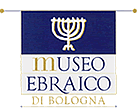LUZZATI. I colori del tempo | Colors of time
How can we give color to time and what kind of time are we talking about when we’re talking about Emanuele Luzzati? There is the time of life and that of history, the one of legend, of fable, and the one of theater, with its pauses and its accelerations, there’s the one of music. And there’s the intimate time of personal existence.
Eight great boards dedicated to Jewish Holidays and to the key moments of human existence make up the central and more eye-catching body of this exhibition dedicated to Emanuele Luzzati. A rich series of other works, which witness the breadth of interests and expressive techniques used by the Genoese Jewish artist, rotates around them.
Men, women and children, animals, fairy-tale characters, legendary figures, from the fixity of the canvas and from the concreteness of ceramics to the movement of theatrical and cinematic animation, live the time of their story clothed by Luzzati’s vivid colors, the strong and cheerful colors of a man free in thought and in action, spared in his long life by the tragedies of the 20th century.
Biography
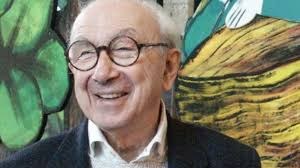 Emanuele Luzzati was born in Genova in 1921, into a family of middle-class Jews who brought him closer to the world of art and theater from an early age. Struck by the racist provisions of 1938, at the age of seventeen he moves, alone, in Switzerland to attend the Ecole des Beaux arts of Lausanne. Here, he makes a group of friends which will always acompain him, in his private and professional life, and he finds the right environment to give free expression to his creative flare, making his debout as a set and costume designer for Solomon and the Queen of Sheba by Alexander Fersen.
Emanuele Luzzati was born in Genova in 1921, into a family of middle-class Jews who brought him closer to the world of art and theater from an early age. Struck by the racist provisions of 1938, at the age of seventeen he moves, alone, in Switzerland to attend the Ecole des Beaux arts of Lausanne. Here, he makes a group of friends which will always acompain him, in his private and professional life, and he finds the right environment to give free expression to his creative flare, making his debout as a set and costume designer for Solomon and the Queen of Sheba by Alexander Fersen.
With his very personal style he masters different techniques and materials – painting, collage of papers and fabrics, papier mache, ceramics, glass – often combining them together to give life to a disparate production which, beyond the scenography, his foundamental occupation, extends to illustration, interior decoration, animation cinema, and the setting up of permanent installations. He lends his work to experimental drama, to opera, to the furnishings of ships, halls, theme parks, synagogues, to the pages of classical texts and those of the Jewish tradition.
Between the 60s and the 70s, together with Giulio Gianini, he makes animated short films that will be worth two Oscar nominations; with Aldo Trionfo and Tonino Conte, he founds the “Teatro della Tosse”, for which he creates scenes and costumes for many shows, including Pinocchio, for which he’ll receive the Premio Ubu. In 1972 he exhibits at the Venice Biennale. In the 80s he illustrates editions of great literary classics such as Grimms’ Fairy Tales, Candide, Pinocchio, Alice in Wonderland, the Decameron, Peter Pan and The Travels of Marco Polo.
In 1997 for the municipality of Turin he sets up a big nativity scene in piazza Carlo Felice, where together with traditional characters coexist those of the most known fairy tales for children, and for the municipality of Santa Margherita Ligure he makes a theme park inspired by Mozart’s The Magic Flute.
From 2000 on he curates the sets for Mozart’s The Magic Flute, the holy representation La cantata dei Pastori by Peppe Barra, Don Chisciotte with the direction of Maurizio Scaparro, The Little Square by Goldoni, the ballet The Nutcracker by Čajkovskij with the direction of Amedeo Amodio, Hänsel and Gretel by Humperdinck for the Opera Theatre of Saint Louis. In 2004 for the Corriere della Sera he illustrates the Divine Comedy by Dante. In 2005 he makes the movie “Genova, Sinfonia della Città”, written and directed by Luigi Berio, with original music by Stefano Cabrera.
On January 26 2007 he dies in Genova, in the house he had always lived in, honored by countless awards, acknowledgments, exhibitions and initiatives that still continue to persist to document his endless creativity.
Pesach
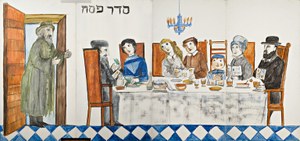 Pesach (“Passover”) starts on the 15 of Nisàn (March-April) and lasts eight days. Anciently, it was thanksgiving holiday for the birth of the new lambs. Another neighboring occurrence, the one of unleavened bread (matzà), merged with Pesach and the two holydays became one. Preparation of Pesach focuses on the elimination of leavened substances from the domestic walls, in remembrance of the dinner eaten in haste on the eve of the escape of the Jews from Egypt, and bread is replaced with the unleavened one. The culmination of Passover rites is made up by the celebration of the dinner, seder, which takes place on the first two evenings of the holiday. Seder represents the continuation of the story of their origins and this uninterrupted narration constitutes, other than an indubitable process of cultural identity, also the direct execution of the Biblical precept which prescribes telling your child about the exit from Egypt. Everything is enclosed in the Haggadà that includes the story of the Exodus and the various rabbinic interpretations in the successive centuries. Luzzati as a painter, but as an illustrator as well, prefers to dwell on this intimate moment rather than on the foods. From the door a strange figure enters, a poor man, maybe, or the prophet Elijah, who is said to visit in disguise during the festivity. The person at the head of the table seems to look him in the eyes and recognize him.
Pesach (“Passover”) starts on the 15 of Nisàn (March-April) and lasts eight days. Anciently, it was thanksgiving holiday for the birth of the new lambs. Another neighboring occurrence, the one of unleavened bread (matzà), merged with Pesach and the two holydays became one. Preparation of Pesach focuses on the elimination of leavened substances from the domestic walls, in remembrance of the dinner eaten in haste on the eve of the escape of the Jews from Egypt, and bread is replaced with the unleavened one. The culmination of Passover rites is made up by the celebration of the dinner, seder, which takes place on the first two evenings of the holiday. Seder represents the continuation of the story of their origins and this uninterrupted narration constitutes, other than an indubitable process of cultural identity, also the direct execution of the Biblical precept which prescribes telling your child about the exit from Egypt. Everything is enclosed in the Haggadà that includes the story of the Exodus and the various rabbinic interpretations in the successive centuries. Luzzati as a painter, but as an illustrator as well, prefers to dwell on this intimate moment rather than on the foods. From the door a strange figure enters, a poor man, maybe, or the prophet Elijah, who is said to visit in disguise during the festivity. The person at the head of the table seems to look him in the eyes and recognize him.
The Wedding
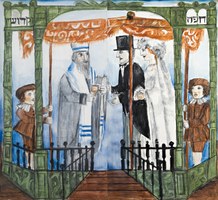 Luzzati accompanies us in the representation of the Jewish wedding seizing it in its most intimate and emotional moment. The scene has been thought as a theatrical box, in which the two spouses and the rabbi are placed under the chuppà, the wedding canopy, which is supported by two pageboys and which is the symbol of the home the new couple will make starting that day.
Luzzati accompanies us in the representation of the Jewish wedding seizing it in its most intimate and emotional moment. The scene has been thought as a theatrical box, in which the two spouses and the rabbi are placed under the chuppà, the wedding canopy, which is supported by two pageboys and which is the symbol of the home the new couple will make starting that day.The school
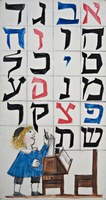 Luzzati’s extraordinary ability as an illustrator for children’s books emerges in this work: a happy boy standing upright in front of his desk, amused under the fall of the twenty-two letters that make up the Hebrew alphabet. The boy, eager to study the language of the Holy Scriptures, seems to want to practice reproducing the letters on his notebook. It’s customary to classify Jews as the “people of the Book”: the relationship with reading and studying is a fundamental characteristic of Jewish culture. Each member of the community has the right and duty of being educated and educate themselves. The Scriptures, the matrix of religious Jewish life, are the basis of education. The depicted boy will surely be studying and preparing his bar-mitzvà: the Saturday that follows his turning thirteen a solemn ceremony will be held, in which he’ll be called for the first time to read a weekly portion of the Torà in the Synagogue. From that moment he’ll come of age religiously and will count in the minyan, the quorum of adult men, necessary for the public recitation of prayers. Various solemnities of the liturgic year have, fully or partially, family and children as protagonists of the celebration.
Luzzati’s extraordinary ability as an illustrator for children’s books emerges in this work: a happy boy standing upright in front of his desk, amused under the fall of the twenty-two letters that make up the Hebrew alphabet. The boy, eager to study the language of the Holy Scriptures, seems to want to practice reproducing the letters on his notebook. It’s customary to classify Jews as the “people of the Book”: the relationship with reading and studying is a fundamental characteristic of Jewish culture. Each member of the community has the right and duty of being educated and educate themselves. The Scriptures, the matrix of religious Jewish life, are the basis of education. The depicted boy will surely be studying and preparing his bar-mitzvà: the Saturday that follows his turning thirteen a solemn ceremony will be held, in which he’ll be called for the first time to read a weekly portion of the Torà in the Synagogue. From that moment he’ll come of age religiously and will count in the minyan, the quorum of adult men, necessary for the public recitation of prayers. Various solemnities of the liturgic year have, fully or partially, family and children as protagonists of the celebration.
Rosh ha-Shanà
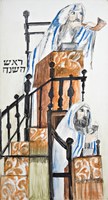 The holiday of Rosh ha-Shanà, the New Year’s, is on the 1st of Tishrì of the Jewish calendar (September/October), and it lasts two days: it’s the beginning of the new Jewish year. Rosh ha-Shanà is also the “Remembrance Day”, as it commemorates the creation of the World and of Adam. But it’s also called Yom ha-Din, the day of Judgment, in which the Creator examines every human taking into account the actions performed in the previous year.
The holiday of Rosh ha-Shanà, the New Year’s, is on the 1st of Tishrì of the Jewish calendar (September/October), and it lasts two days: it’s the beginning of the new Jewish year. Rosh ha-Shanà is also the “Remembrance Day”, as it commemorates the creation of the World and of Adam. But it’s also called Yom ha-Din, the day of Judgment, in which the Creator examines every human taking into account the actions performed in the previous year.
Divine judgment will be sealed on Kippùr, the day of atonement.
Between Rosh ha-Shanà and Kippùr are the ten penitential or terrible days: a yearly obligatory path of reflection, examination of conscience, and spiritual renovation. Rosh ha Shanà’s culminating rites take place in the synagogue: it’s here that Luzzati represents an intimate atmosphere in which the two characters are wrapped in the tallit, the decorated shawl that the Jews wear to pray. Below, on a bench, there is the one who leads the recitation of prayers and the invocations for forgiveness. Above, on the pulpit, the rabbi is caught in the act of playing the shofar, the ram’s horn that symbolically rallies the people. The shofàr refers to the biblical episode of Isaac’s “sacrifice”, but the sound of the instrument also emphasizes a joyful occasion, the beginning of the new year: good wishes are exchanged and, with the wish that the new year will be sweet, it’s customary to eat a slice of apple dipped in honey.
The rabbi
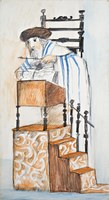 The synagogue is the place where Jews rally to pray, study, discuss, and finding hospitality in case of indigence.
The synagogue is the place where Jews rally to pray, study, discuss, and finding hospitality in case of indigence.
Synagogues have always existed, but during the Diaspora and after the destruction of the Second Temple, they become the privileged place for the maintaining of Jewish tradition and identity. On the eastern wall there is always positioned the aròn ha-qodesh, the holy ark, in which the Sefer Torà, the roll of law, is kept.
Luzzati’s rabbi, pictured here, stands on a tevà, the raised stage for the reading of the Torà.
The rabbi is considered a teacher; after he has studied, he has received order. He’s called to resolve doubts regarding Jewish law, to advice, to admonish and be an example with his conduct of life. So, he’s a point of reference for the community. That’s why Luzzati’s rabbi has a good-natured expression, he’s authoritative but engaging: he is the representation of an inclusive Judaism and that is open to dialogue, so sure of himself that he doesn’t feel the need to defend himself and withdraw into himself.
Sukkòt
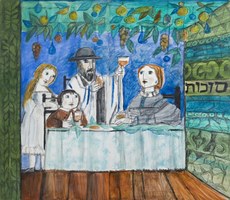 Sukkòt (“Huts”) starts on the 15th of Tishrì and lasts seven days: it’s one of the 3 pilgrimage or harvest festivals and it’s the most joyous of the biblical festivals. The celebration recalls the forty years passed by the Jews in the desert during the Exodus. The precept that characterizes the festival is the construction in the open of the sukkà, which must have three walls a cover of branches that allows to see the sky.
Sukkòt (“Huts”) starts on the 15th of Tishrì and lasts seven days: it’s one of the 3 pilgrimage or harvest festivals and it’s the most joyous of the biblical festivals. The celebration recalls the forty years passed by the Jews in the desert during the Exodus. The precept that characterizes the festival is the construction in the open of the sukkà, which must have three walls a cover of branches that allows to see the sky.
Inside, time is spent in joy by eating, studying, talking, and by sleeping during the night too. Abandoning his own house to live in a fragile hut, the Jew remembers that it’s not the bricks or the mortar of the house that offer protection, but God Himself.
In synagogal functions a very important role is reserved to another key symbol of this festival: the “Four Species” (lulàv). They are made up by a palm tree branch, by a willow branch, and by a myrtle branch; they are kept in the right hand, while in the left is an etrog (cedar) one; together they symbolize the fertility of the earth at the end of the harvest. During the prayer in the synagogue, the lulàv is waved in the direction of the four cardinal points to ask for rain and for God’s blessing, and a tour is made around the synagogue, pronouncing hymns marked by the refrain Hosha‛nà (”save us”).
The Cemetery
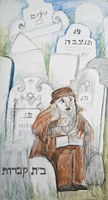 Cemeteries often make up the only still tangible memory of ancient and now gone Jewish communities.
Cemeteries often make up the only still tangible memory of ancient and now gone Jewish communities.
The underlying idea of the artistic vision of this panel by Luzzati is not a specific place, but probably the sum of different Jewish graveyards. In the composition by the vertical cut, played on grey and earth tones, Luzzati placed, sitting in a small gap, a good Jew intent on praying, bent over himself with a thoughtful expression and a scared look, and with the hand caressing his long beard that, by respecting the first 30 days of mourning (avelùt), he couldn’t cut. As a manifestation of his pain he wears a simple dress and with a cut lapel flap (Qeri‛à).
During the mourning time, the qaddìsh, a prayer of exaltation and resignation to the will of God, is recited in memory of the deceased.
In Jewish cemeteries, the graves are made up of a simple tombstone with ornaments reduced to the essential to avoid associating splendor to the austerity of death.
It’s a Jewish custom to bring on the graves not flowers but a pebble, custom that is put in relation with the times in which it was necessary to indicate a burial with a pile of stones.
Channukkà
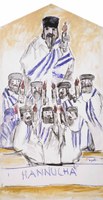 The festival of Channukkah (“inauguration” or “consecration”), also called “Festivals of Lights”, starts on the 25th of Kislèw, winter month; it lasts eight days and remembers the rededication of the Temple of Jerusalem, dedicated to Olympian Zeus during the Greek domination of the 2nd century BCE. When the Jews reconquered independence they searched immediately for pure oil to aliment the menorà, the great seven-branched candlestick of the Temple. They found just an ampoule of it, barely enough for a day, but, miraculously, that quantity lasted sufficed for eight days. The symbolic object of the festival is the chanukiyyà, a lamp with eight lights plus one, the shammàsh (“servant”), placed in a prominent position. The lights are lit progressively, one per night, through the shammàsh, so that only on the last day they burn all together.
The festival of Channukkah (“inauguration” or “consecration”), also called “Festivals of Lights”, starts on the 25th of Kislèw, winter month; it lasts eight days and remembers the rededication of the Temple of Jerusalem, dedicated to Olympian Zeus during the Greek domination of the 2nd century BCE. When the Jews reconquered independence they searched immediately for pure oil to aliment the menorà, the great seven-branched candlestick of the Temple. They found just an ampoule of it, barely enough for a day, but, miraculously, that quantity lasted sufficed for eight days. The symbolic object of the festival is the chanukiyyà, a lamp with eight lights plus one, the shammàsh (“servant”), placed in a prominent position. The lights are lit progressively, one per night, through the shammàsh, so that only on the last day they burn all together.
Luzzati’s work was realized on an elongated panel that recalls that of a flame. On a luminous background, there are represented eight rabbis wrapped in the tallìt, plus a bigger one, arranged like the lights of the chanukiyyà. All of them hold up a candle, the light of Judaism that they first must always keep lit. On their head they wear the shtreimel, the fur hat of the Chasidim, a detail that recalls the spiritual world of Eastern Europe, the lost Yiddishland which was swept away in the 20th century by the pogrom and the Shoah.
The Sukkà
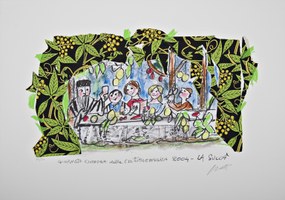 We find ourselves in front of another representation of the festival of Sukkòt and of the ritual hut here represented by a large scrap of collage-applied paper that embraces a long table, at which the rabbi and other people are seated. The atmosphere is cheerful, they read, they toast, and the fruit of the cedar, repeated here and there together with green leaves that probably recalls lulàv’s, triumphs.
We find ourselves in front of another representation of the festival of Sukkòt and of the ritual hut here represented by a large scrap of collage-applied paper that embraces a long table, at which the rabbi and other people are seated. The atmosphere is cheerful, they read, they toast, and the fruit of the cedar, repeated here and there together with green leaves that probably recalls lulàv’s, triumphs.
Other than the color yellow, which recalls the one of the flowers on the paper used for the collage and which gives a joyful and sunny tone to the whole composition, the fruit of the cedar, a fragrant and tasty fruit, represents in the Talmudic tradition whoever to wisdom follows with wise actions.
The other three plants of the lulàv can have a symbol interpretation as well: the date palm tree, which has a tasty fruit but has no scent, symbolizes who to wisdom doesn’t follow with actions; myrtle, scented but with no flavor, indicates men who act without wisdom; willow, odorless and tasteless, in the end, represents who’s without both wisdom and actions.
The serigraphy was realized in 2004 on occasion of the European Day of Jewish Culture on the initiative of Jewish Cultural Heritage Foundation in Italy.
Luzzati and Theatre
Luzzati’s relationship with Theatre is expressed mainly though his activity as a set and costume designer in prose, opera, ballet. Alongside directors and actors very different from each other, he collaborates in the staging of classical and contemporary texts, suggesting bold and original solutions, renovating the use of space, color, materials.
Numerous are his contaminations through which he moves images and characters from a language to another (emblematic is the case of Pulcinella, main character in movies, theatrical shows, and short stories).
His career is studded by numerous collaborations.
Among the most meaningful the one with Aldo Trionfo and Alessandro Fersen, which marks Luzzati’s launch in the world of entertainment, the one with Giulio Gianini, with whom he produces extraordinary animation short films (the luckiest The Magpie, with music by Gioachino Rossini, of 1964, and Pulcinella, of 1973).
In 1961 with Franco Enriquez, Valeria Moriconi, and Glauco Mauri he founds the Compagnia dei Quattro, in 1975 with Tonino Conte he founds and directs the Teatro della Tosse in Genoa, and from 1978 he makes scenes and costumes for the Teatro Gioco Vita. From 1983, with the Don Chisciotte, he starts a collaboration with Maurizio Scaparro.
Dulcinea
 Dulcinea costume realized by the Satoria Farini
Dulcinea costume realized by the Satoria Farini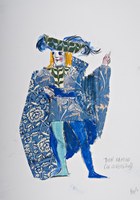 |
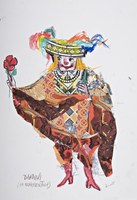 |
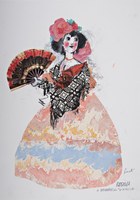 |
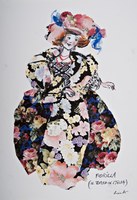 |
These four original sketches were made by Emanuele Luzzati for the fourth edition of the review “Tende al Mare”, art review that was born in Cesenatico in Summer 1998 by an idea of the Nobel Prize Dario Fo and an agreement with the Institute for Cultural Heritage of the Emilia Romagna region, in the occasion of the exhibition dedicated to Franca Rame and Dario Fo, and which today is considered one of the most interesting and original outdoor art displays. Luzzati’s choice had fallen on the musical strand, choosing characters taken from Rossini’s and Mozart’s works. The young students of the Academy of Ravenna reproduced the Master’s drawings in their “sea tents”, which are in the municipal collections of Cesenatico.
Luzzati as a Ceramist
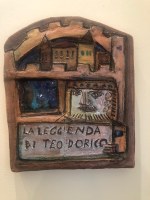 The most active moment for Luzzati as a ceramist is in the ‘50s-‘70s. Those are the years in which ceramics is rediscovered by artists such as Picasso and Chagall on one hand, and Fontana, Sassu, Fabbri, Scanavino on the other, concentrated respectively around tow traditional poles of work of this material, Vallauris in Provence and Albissola in Liguria.
The most active moment for Luzzati as a ceramist is in the ‘50s-‘70s. Those are the years in which ceramics is rediscovered by artists such as Picasso and Chagall on one hand, and Fontana, Sassu, Fabbri, Scanavino on the other, concentrated respectively around tow traditional poles of work of this material, Vallauris in Provence and Albissola in Liguria.
In ceramics, the two opposite tendencies – abstract and figurative – seem to find their conciliation, a reason why antithetical artists can also find themselves working side by side.
From the Pozzo della Garitta Furnace by Bartolomeo Tortarolo, called “the White”, a vast production of Luzzati’s works – vases, panels, plates – comes out, produced both individually and, often, in collaboration with architects such as Gustavo Pulitzer and Nino Zoncada, and destined to interior design, in most cases of ocean liners.
Unlike other business branches, which also happened to Luzzati by chance, ceramics is a very specific choice of the artist.
In it his creative flair finds a full expression, especially in the anthropomorphic and zoomorphic vases, unedited revisitation of a tradition that has its roots in the ancient civilizations of the Mediterranean.
Chanukkà Lamp
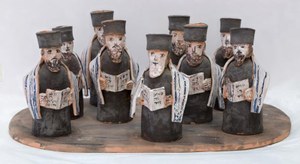 In this works the rabbis are vases, or vases that become rabbis: the figures will bear the candles and oil, to remember that as teachers they are containers of knowledge, those who will pass on traditions.
In this works the rabbis are vases, or vases that become rabbis: the figures will bear the candles and oil, to remember that as teachers they are containers of knowledge, those who will pass on traditions.
On a simple table, the nine terracotta and polychrome enamels figures find place, put in scattered order and dressed following the most typical methods of representation: the characters, with small physiognomic differences, wear long tunics and black headdresses on which are placed the candles for ignition; from their shoulders, the characteristic tallìt (prayer shawls) hang, white with blue stripes. The role of the ninth light, the shammàsh, is here represented by the only rabbi placed in front of the group.
The Legend of Theodoric
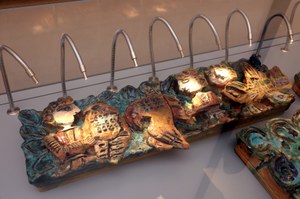 The cycle of seven ceramics dedicated to the Legend of Theodoric was made by Luzzati in 1956 for the Classensis Tourist Hotel of Ravenna and is now part of a private collection.
The cycle of seven ceramics dedicated to the Legend of Theodoric was made by Luzzati in 1956 for the Classensis Tourist Hotel of Ravenna and is now part of a private collection.
The Ostrogoth Theodoric, raised at the court of Constantinople, had been educated by the best teachers of the city. When he took the lead of his people, he consolidated his relationship with the Roman Empire, leading numerous battles against its enemy populations. In 488 he invaded Italy and, beaten Odoric, he obtained, ten years later, the patrician title. After long years of reign in which he maintained the Roman legal order, implemented reclamation works, and gave impetus to construction, especially in Rome and in Ravenna, in the last years his relationships with other barbaric reigns, and with the emperor, deteriorated. Become suspicious, he got his magister Boethius and his father-in-law Symmachus killed; but it was especially his decision to imprison the pope John I, who died in jail, that created a dark aura around him that gave rise to a legend about his death. The version of the legend by which Luzzati’s ceramics are inspired is the one told by Giosuè Carducci in a poem in the Rime Nuove and it says that the emperor was kidnapped by a demon-possessed horse which, crossed all of Italy, made him fall in the crater of Vulcan.
Luzzati as an illustrator
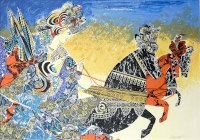 Luzzati finds for himself in the qualification of “illustrator”, to the confluence of art and craftsmanship, the best way to express the richness of his fantasy world, the immediacy and expressiveness of his work of his very personal style.
Luzzati finds for himself in the qualification of “illustrator”, to the confluence of art and craftsmanship, the best way to express the richness of his fantasy world, the immediacy and expressiveness of his work of his very personal style.
To Luzzati, to illustrate means to comment with pictures, to clarify, to exalt; it means to celebrate, to retell, to reinvent, to bring, beyond that story, other stories. His style implies a vast figurative culture: in the same picture, “high” references from the history of art and the “low” popular and folkish ones can overlap and mix, in a new and intelligent dough, in an infinite quoteistic play.
In illustration, Luzzati has greatly used the technique of collage, using ripped or cut papers, especially to represent the characters’ clothes, while the faces and hands are usually drawn. In his creative processes, he uses poor materials, residual materials. His poetics of waste and cutting have significant analogies to the games for which children use advanced materials.
Among his vast production, begun in 1968 for Emme Edizioni in Milan, we remember the drawings for Gli uomini del libro by Giacoma Limentani (Adelphi, 1975), for Le filastrocche lunghe e corte by Gianni Roadri (Editori Riuniti, 1981), for the Haggadà di Pesach (La Giuntina, 1984), for the Fiabe scelte dei fratelli Grimm edited by Giorgio Soavi (Olivetti, 1988), for Candido by Voltaire (Nuages, 1990), for the Orlando innamorato by Matteo Boiardo (1994).
Luzzati’s illustrations are a game of chase, light figures or even richer that on the one hand refer to stories and fairly-tales, but on the other have a specific intent to communicate and evoke that enchanted world that humanity carries within, and that sometimes there’s a need for someone to show it and remember it.
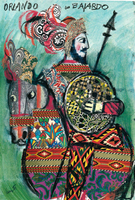 Orlando on Baiardo
Orlando on Baiardo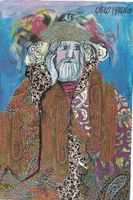 Charlemagne
Charlemagne
These two works are part of the collection of 41 boards inspired by the poem Orlando Innamorato, commissioned by the Municipality of Scandiano in 1994 to celebrate the 500th anniversary since the death of Matteo Maria Boiardo. The deeds, the battles, the extraordinary characters by Boiardo have enriched the story of our culture and literature, inspiring the masterpieces in octaves of the following centuries. In the same way, Luzzati, with great versatility in reworking all materials, celebrates with his boards the intertwining narrated in rhyme by the sixteenth-century author: “I have always been fascinated by chivalry tales, also for the irony that exists both in Boiardo and Ariosto, or better for the sake of game, for their telling while playing, having fun, even if in their works there are tragic pages, dramatic events, but always rendered with a certain detachment.”
Jews in Bologna
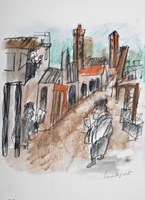 In this depiction, too, we don’t find ourselves in front of a specific street or place in Bologna.
In this depiction, too, we don’t find ourselves in front of a specific street or place in Bologna.
It’s perhaps a free interpretation of the old Jewish ghetto the one we see with the Asinelli tower in the background, but other towers and a thirteen-century house with long wood columns bring us back to other glimpses of the city and represent, once again, a synthesis of it.
In Luzzati’s vision, the flat city of the Po takes on a curiously vertical perspective that brings it a little closer to Genoa, in which the artis has always lived and in which, according to his words, with the piling up of its buildings, is already a scenography for itself.
The arcades and the colors in the brick tone remind us of the essence of Bologna’s architecture, while Jews dressed in black, timeless and placeless, roam and overlook from the balconies while wrapped in the tallit and with their face immersed in reading: the classic insignia of a Judaism that keeps bringing forward it’s own tradition.
The Catacombs
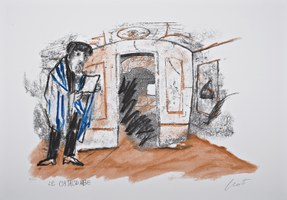 Jews living in Italy also had underground burial grounds, which are, the most ancient, dating back to the II-III century CE. In Rome alone we can find six catacombs, demonstration of a wide and florid community, to which must be added the ones in south Italy, such as the one of Venosa, of Sardinia (Sant’Antioco), and of Sicily (Noto and Syracuse). Their protection, following the new concordat signed with the Church in 1984, has now passed to the Italian state.
Jews living in Italy also had underground burial grounds, which are, the most ancient, dating back to the II-III century CE. In Rome alone we can find six catacombs, demonstration of a wide and florid community, to which must be added the ones in south Italy, such as the one of Venosa, of Sardinia (Sant’Antioco), and of Sicily (Noto and Syracuse). Their protection, following the new concordat signed with the Church in 1984, has now passed to the Italian state.
Not all still preserved and visitable, the surviving Jewish catacombs have returned epigraphs and wall paintings that Luzzati lets us understand in his drawing, even though he doesn’t portray a specific place, but summing up the character that unites all these Jewish underground necropolises in Italy.
In the ancient site, a rabbi in contemporary clothes, wrapped in the tallit and with his head covered, as the sacrality of the cemetery imposes, seems to suggest the idea of a people, the Jewish one, that has its roots in the past and goes on in the present. Between his hands a book, perhaps the Torah, the main text from which Judaism draws its existence.
The serigraphy was realized in 2004 on occasion of the European Day of Jewish Culture on the initiative of Jewish Cultural Heritage Foundation in Italy.
Animation Cinema
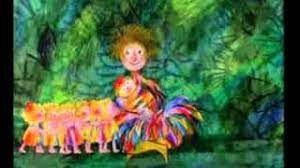 In the second half of the ‘50s, Luzzati meets the set designer and photography director Giulio Gianini. Gianini owns a puppet theatre with which he entertains relatives and friends, and he has a passion for cartoons. Both his interests meet perfectly Luzzati’s curiosities and character. Together, they venture therefore in the world of cinematographic animation bringing originality and experimentation in it: Luzzati deals with graphics takes care of the technical aspects, script and direction are shared. After several happy experiences of shorts created around stories (Marco Polo), characters (Pulcinella), fairy tales (Ali Baba), operas (L’Italiana in Algeri), in 1976 the masterpiece of the Flauto Magico is born, where Luzzati’s creative genius transforms recycled materials into wonderful images, animated by Gianini with surprising light effects and deepness. The choice to have Papageno narrate the story, a character in flesh and blood played by the actor Marcello Bartoli, underlines the playful eighteen-century spirit of Mozart’s work, becoming a true poetic interpretation.
In the second half of the ‘50s, Luzzati meets the set designer and photography director Giulio Gianini. Gianini owns a puppet theatre with which he entertains relatives and friends, and he has a passion for cartoons. Both his interests meet perfectly Luzzati’s curiosities and character. Together, they venture therefore in the world of cinematographic animation bringing originality and experimentation in it: Luzzati deals with graphics takes care of the technical aspects, script and direction are shared. After several happy experiences of shorts created around stories (Marco Polo), characters (Pulcinella), fairy tales (Ali Baba), operas (L’Italiana in Algeri), in 1976 the masterpiece of the Flauto Magico is born, where Luzzati’s creative genius transforms recycled materials into wonderful images, animated by Gianini with surprising light effects and deepness. The choice to have Papageno narrate the story, a character in flesh and blood played by the actor Marcello Bartoli, underlines the playful eighteen-century spirit of Mozart’s work, becoming a true poetic interpretation.
To the Flauto follows a lighter production, to which L’uccello di fuoco belongs, the ballet by Stravinskij for which some time before Luzzati had already made scenes and costumes.
